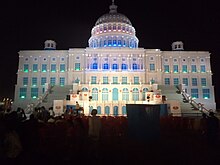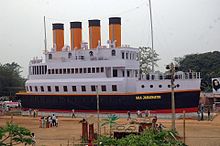193.52.200.83 (talk) |
|||
| Line 55: | Line 55: | ||
==History== |
==History== |
||
[[File:Jagaddhatri Krishnanagar Rajbati.jpg|thumb|Jagadhhatri Puja at Krishnanagar Royal Palace]] |
[[File:Jagaddhatri Krishnanagar Rajbati.jpg|thumb|Jagadhhatri Puja at Krishnanagar Royal Palace]] |
||
In [[Bengal]] it is popularly believed that [[Maharaja Krishna Chandra]] of [[Nadia district|Nadia]] started Jagaddhatri Puja. However, it is not verified and cannot be correct as Chandannagar's Indranarayan Roy Choudhury's Jagadhatri Puja precedes the date when it was started by Maharaja Krishna Chandra in Krishnanagar. Jagadhatri Puja is very popular in [[Krishnagar]], [[Rishra]], [[Chandannagar]], [[Boinchi]]. |
In [[Bengal]] it is popularly believed that [[Maharaja Krishna Chandra]] of [[Nadia district|Nadia]] started Jagaddhatri Puja. However, it is not verified and cannot be correct as Chandannagar's Indranarayan Roy Choudhury's Jagadhatri Puja precedes the date when it was started by Maharaja Krishna Chandra in Krishnanagar. Jagadhatri Puja is very popular in [[Krishnagar]], [[Rishra]], [[Chandannagar]], [[Bhadreswar]], [[Boinchi]]. |
||
The Jagadhatri puja of Bose family, Palpara, deserves a special mention in this regard. The puja of this family initially used to be held in their ancestral home in Murshidabad. Folklore has it that this puja was started in 1788. The puja was later shifted to its present location in Chandannagar, where many of the family members now live. The exact history of the deity is unknown, but family records date it back to 1640. |
The Jagadhatri puja of Bose family, Palpara, deserves a special mention in this regard. The puja of this family initially used to be held in their ancestral home in Murshidabad. Folklore has it that this puja was started in 1788. The puja was later shifted to its present location in Chandannagar, where many of the family members now live. The exact history of the deity is unknown, but family records date it back to 1640. |
||
Revision as of 06:22, 28 September 2015
| Jagaddhatri | |
|---|---|
| Consort | Shiva |
In Hinduism, Jagaddhatri or Jagadhatri (Devnagri: जगद्धात्री, Bengali: জগদ্ধাত্রী, Oriya: ଜଗଦ୍ଧାତ୍ରୀ, 'the Protector of the World') is a form of Durga Devi, the supreme goddess. Her worship is more common in West Bengal than the other parts of India. Her cult is directly derived from Tantra where she is a symbol of sattva beside Durga and Kali, respectably symbolized with Rajas and Tamas.
She is celebrated on Gosthastami. It is also referred to as another Durga Puja as it also starts on Asthami tithi and ends on Dashami tithi. The date of the puja is decided by the luni-solar Hindu calendar.
In Tantra and Purana, Jagaddhatri is depicted as being the colour of the morning sun, three-eyed and four-armed, holding Chakra, conch, bow and arrow, clothed in red, bright jewels and nagajangopaveeta, a symbol of Yoga and the Brahman. She rides a lion standing on the dead Karindrasura, the Elephant Demon. “Jagaddhatri arises in the heart of a person," said Sri Ramakrishna, “who can control the frantic elephant called mind.”
Though she is worshipped all over West Bengal and some places of Odisha, Jagaddhatri Puja in Chandannagar, Hoogly, Rishra, Boinchi, Tehatta, Krishnanagar, Nadia, Ashoknagar Kalyangarh, Ichapur-Nawabganj, North 24 PGS, Gopalbera, Burdwan and Baripada, have a special socio-cultural celebration. In Kolkata, too, Jagaddhatri Puja is a major autumnal Hindu event after Durga Puja and Kali Puja. In Ramakrishna Mission, Jagaddhatri Puja was initiated by Sarada Devi, Sri Ramakrishna’s wife who was, according to popular Bengali belief, an avatar of Devi and observed in the centres of the Mission all over the world.
Etymology

Generally, Jagaddhatri is referred as another name of Durga. In Sanskrit, Bengali and Assamse the word 'Jagaddhatri' literally means 'Holder (dhatri) of the World (Jagat)' . According to Sri Ramakrishna, “(Jagaddhatri) holds the World. If she wouldn’t, the World might fall down. This explanation can be applied for both Durga and Jagaddhatri. That is why in the hymns, the goddess is always referred as ‘Jagaddhatri Durga -
জয়দে জগদানন্দে জগদেকপ্রপূজিতে
জয় সর্বগতে দুর্গে জগদ্ধাত্রি নমোঽস্তুতে
Transliteration: jayade jagadanande jayadekaprapujite.
jaya sarvagate Durge Jagaddhatri namahstute.Translation: I hail Thee, o all-pervasive Jagaddhatri Durga, Thou art victorious and symbol of the joys of the world; it is only Thou in the world, who can be worshipped properly. Victory to Thee.
Like most of other Hindu deity, Jagaddhatri is also known as other names like Karindrasuranisudini (Slayer of the Elephant Demon), Maheswari (the Great Goddess), Shaktacharpriya (the Goddess who loves to be worshiped as according to the practices of the Sakta sect of Hinduism, or Shaktism), Adharabhuta (the Bearer of the World) etc.
Pauranik lore

As per ancient Pauranik lore of the Hindu scriptures, soon after the victory over Mahishasur the Devatas became highly egoistic. They thought because of lending to Durga their instruments the mighty asuras were vanquished. To make them understand that the primordial power is alone behind every action, the Brahman appeared before the Devatas in the form of effulgent Yaksha.
Bewildered by its presence one by one the Devatas approached Yaksha. First the god of wind Vayu. The Yaksha asked him what he could do. The Vayu replied that he could throw away huge trees, tumble high mountains. The Yaksha then placed a small grass and asked him to move it. The Vayu utilised all his powers but lo! he could not even displace it. So also the god of fire Agni, could not even burn it. Likewise one by one the Devatas failed.
And it dawned on them that their powers are in reality not their own but derived from the supreme power who as protecting mother holds the entire creation and therefore called Jagaddhatri. Anybody who worships Jagaddhatri becomes absolutely egoless and a true servant of the world which is nothing but a manifestation of the Brahman.
History

In Bengal it is popularly believed that Maharaja Krishna Chandra of Nadia started Jagaddhatri Puja. However, it is not verified and cannot be correct as Chandannagar's Indranarayan Roy Choudhury's Jagadhatri Puja precedes the date when it was started by Maharaja Krishna Chandra in Krishnanagar. Jagadhatri Puja is very popular in Krishnagar, Rishra, Chandannagar, Bhadreswar, Boinchi.
The Jagadhatri puja of Bose family, Palpara, deserves a special mention in this regard. The puja of this family initially used to be held in their ancestral home in Murshidabad. Folklore has it that this puja was started in 1788. The puja was later shifted to its present location in Chandannagar, where many of the family members now live. The exact history of the deity is unknown, but family records date it back to 1640.
Jagaddhatri figures in the semi-historical fictional work 'Anandamath' written by Bankim Chandra Chatterjee, from which book the national song of India "Vande Mataram" is taken. In the novel, Kali, Durga and Jagaddhatri are depicted as three aspects of 'Bharat Mata' (Mother India) - Jagaddhatri as the mother used to be, Kali as the mother now is, Durga as the mother will be in future. The trio of goddesses are shown as the object of worship of a group of ascetics who form the protagonists of the story.
Jagadhatri Mela








After Ratha Yatra, Jagadhatri Mela at Bhanjpur Jagadhatri Podia, is the biggest mela of Baripada, Odisha. It is the festival of Maa Jagadhatri, Goddess of the whole world. There is an 8–15 days mela(carnival) also known as mini Bali Jatra named after Cuttack's Bali Jatra which takes place at Jagadhatri Mela Podia, Bhanjpur, near the Bhanjpur railway Station during the month of October–November. It is celebrated on Gosthastami. It is also referred to as another Durga Puja as it also starts on Asthami tithi and ends on Dashami tithi. The date of the puja is decided by the luni-solar Hindu calendar.
In 2012, the sarbajanina Maa Jagadhatri puja[2] has been started from 21 November. But the mela continued from 26 November to 7 December (for the first time it was for such a long period of 13 days). As the puja was celebrating its Diamond Jubilee for completing 60 years.
In 2013, the sarbajanina Maa Jagadhatri puja has been started from 11 November. But to commemorate the loss of Odisha, specifically Mayurbhanj district and Baripada due to Phailin and post Phailin flood, there will be no Cultural Program or Live telecast of this(2013) year's Jagadhatri Puja and Mela on Blue Sky (Local Cable Provider). But Mela will continue from 14 to 25 November 2013.
Every year its main attraction is the Puja Torana(Pendal) and the Mela. The Pendal is decorated as a famous monument like in 2011 it was a miniature of US Capitol Building, USA. This year, it is Lalitha Mahal, Mysore. From year 2000 it has been a tradition to decorate the torana as a special infrastructure. Tajmahal, Agra; Victoria Memorial (India), Kolkata; Titanic Ship; Lotus Temple, New Delhi; Golden Temple, Punjab etc. were also mimicked in the previous years since 2000 to 2006. As a tribute to 26/11 Hotel Taj Mahal Palace & Tower, Mumbai attack victims, the torana of year 2009 is a lookalike of that hotel. The pictures showing here are the toranas decorated from 2007 to 2012 as previous year's pictures are not available.
Puja Subscription
The puja subscription is one of the drawback jagadhatri puja. Some of the clubs who in name of puja demand hefty amount of money from common people. And if they do not provide the money they are tortured. The money which is been received by subscriptions and sponsorships are been used in organizing puja and also the leftover money is been used to do parties and other recreational activities of club members. Police also cannot do anything just because of the local councellors.
References
Further reading
- McDermott, Rachel Fell (2011). Revelry, Rivalry, and Longing for the Goddesses of Bengal: The Fortunes of Hindu Festivals.
External links
- Jagaddhatri Puja posted by Paromita
- The Mela ground where Jagadhatri Mela takes place every year
- "Jagadhatri mela kicks off with much fanfare" is the headline of e-news site webindia123.com as the famous Bhanjpur Jagadhatri Mela started on 21 Nov 2012

